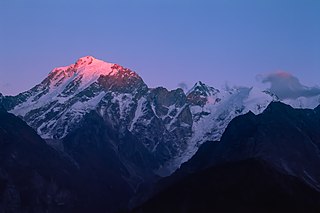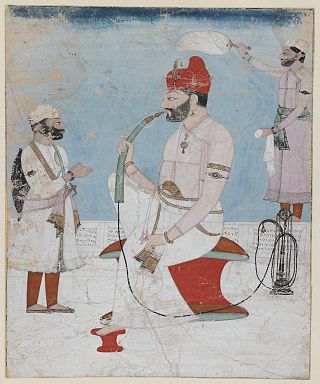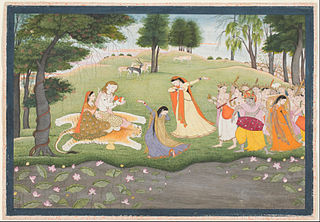Related Research Articles

Himachal Pradesh is a state in the northern part of India. Situated in the Western Himalayas, it is one of the thirteen mountain states and is characterised by an extreme landscape featuring several peaks and extensive river systems. Himachal Pradesh is the northernmost state of India and shares borders with the union territories of Jammu and Kashmir and Ladakh to the north, and the states of Punjab to the west, Haryana to the southwest, Uttarakhand to the southeast and a very narrow border with Uttar Pradesh to the south. The state also shares an international border to the east with the Tibet Autonomous Region in China. Himachal Pradesh is also known as Dev Bhoomi, meaning 'Land of Gods' and Veer Bhoomi which means 'Land of the Brave'.

Kangra district is the most populous district of the Indian state of Himachal Pradesh. Dharamshala is the administrative headquarters of the district.

Chamba district is the northwestern district of Himachal Pradesh, in India, with its headquarters in Chamba town. The towns of Dalhousie, Khajjhiar and Churah Valley are popular hill stations and vacation spots for the people from the plains of northern India.

Kangri is an Indo-Aryan language, spoken in northern India, predominantly in the Kangra, Una and Hamirpur of Himachal Pradesh as well as in some parts of Mandi and Chamba districts of Himachal Pradesh and Gurdaspur, Rupnagar and Hoshiarpur districts of Punjab. Kangri language is also spoken in Duggar i.e. Jammu region and in a few villages of Pakistan by the people belonging to the families migrated from Kangra Valley. It is associated with the people of the Kangra Valley. The total number of speakers has been estimated at 2.3 million as of 2024.

Kangra is a city and a municipal council in Kangra district in the Indian state of Himachal Pradesh. It is also known as Nagarkot.
Katoch is a Chandravanshi Rajput clan. The Katoch Clan is considered to be oldest Ruling Royal Dynasty of the world.Their areas of residence are mainly in the Indian states of Himachal Pradesh, Punjab, and Uttarakhand, and the Union territory of Jammu and Kashmir. Traditionally resided in Kangra Fort, Trigarta Kingdom, Jalandhar, Multan.

Sansar Chand was a Rajput ruler of the erstwhile Kangra State in what is now the Indian state of Himachal Pradesh.
Palampur is a hill station and a municipal corporation situated in the Kangra District in the Indian state of Himachal Pradesh.

Chamba is a town in the Chamba district in the Indian state of Himachal Pradesh. According to the 2001 Indian census, Chamba has a population of 20,312 people. Located at an altitude of 1,006 metres (3,301 ft) above mean sea level, the town is situated on the banks of the Ravi River, at its confluence with the Sal River.
Dalhousie cantonment is a town in Dalhousie, just 50 km from Chamba town in Chamba district in the state of Himachal Pradesh, India.
Kangra may refer to:

Kangra painting is the pictorial art of Kangra, named after the Kangra State, a former princely state of Himachal Pradesh, which patronized the art. The art style became prevalent with the fading of the Basohli school of painting in the mid-18th century. Later, Kangra paintings were produced in such magnitude, both in content and volume, that the Pahari painting school came to be known as the Kangra painting school. Kangra painting style was registered under the Geographical Indication of Goods Act, 1999 on 2nd April 2012.

Baragaon is a village in Kumarsain subdivision of Shimla district in the Indian state of Himachal Pradesh.

Guler was a minor kingdom in the Lower Himalayas. Its capital was the town of Haripur Guler, in modern-day Himachal Pradesh. The kingdom was founded in 1415 by Raja Hari Chand, a scion of the ancient royal family of Kangra. The etymology of the word Guler can be traced to the word Gwalior, meaning the abode of cowherds. One of the foremost schools of Pahari miniatures is named after this small principality.

Vijay Sharma is an Indian painter and art historian, known for his expertise in the Pahari school of miniature painting. He was honored by the Government of India, in 2012, with the fourth highest Indian civilian award of Padma Shri.

Nurpur kingdom in the Himalayan foothills of India was founded in 1064 A.D at north-eastern Bari Doab between the Ravi and the Beas rivers at the fusion of Kangra, Duggar, Majha, Dharab and Chamba areas which ended in 1815. The remnants of Nurpur kingdom exist as ruined forts, restored temples, water bodies, and canals in Nurpur tehsil, Fatehpur tehsil, Pathankot tehsil, Dhar Kalan tehsil, Jawali tehsil, Indora tehsil Bhattiyat tehsil, and Sihunta tehsil.
Ichhi is a village and a Village Panchayat in Kangra district in the Indian state of Himachal Pradesh. Ichhi village is 8 kilometres from Kangra.

The Nepal–Sikh war was a small conflict in 1809 between the forces of the Western Province of Kingdom of Nepal under General Amar Singh Thapa and the Sikh Empire under Maharaja Ranjit Singh.
Shakoh is a village panchayat, of Lambagaon block, Jaisinghpur tehsil of the Kangra district of Himachal Pradesh, in India. It is located in the border area of the Kangra-Hamirpur district. It is the central point to Hamirpur (37Km) and Palampur. Shakoh is just 7 km away from Sujanpur Tira, a sub-town in the Hamirpur district, where Sainik School of Himachal is located. Kangra is one of twelve districts in Himachal Pradesh. Pin Code of Shakoh Village is 176 082 and the people of Shakoh village use the Pahadi dialect (Kangri).
Gautam Sharma "Vyathit", is a folklorist, playwright, and poet from Himachal Pradesh, India. He is also known as Gautam Chand Sharma "Vyathit" or just Gautam Vyathit. He is noted for his literary works in Dogri and Hindi, as well as for his various efforts to preserve and nurture the endangered folk arts of Himachal Pradesh, especially those of the Kangra region. Vyathit was the joint recipient of the 2007 Sahitya Akademi Award for his contributions to Himachali languages and literature. 'Vyathit', Gautam Sharma's pen-name in Hindi, means 'pained', or 'distressed'.
References
- ↑ "Rait". findmygov.in. Retrieved 2024-10-14.
- ↑ "Development Block | District Kangra, Government of Himachal Pradesh | India" . Retrieved 2024-10-14.
- ↑ Study on the drainage system, mineral potential and feasibility of mining in river/ stream beds of district Kangra, Himachal Pradesh (PDF). Geological Wing, Udyog Bhavan, Govt. of Himachal Pradesh. p. 112.
- ↑ Srivastava, P.; Rajak, M.K.; Singh, L.P. (2009). "Late Quaternary alluvial fans and paleosols of the Kangra basin, NW Himalaya: Tectonic and paleoclimatic implications". Catena. 76 (2): 135–154. doi:10.1016/j.catena.2008.10.004.
- ↑ Archaeology, India Dept of (1975). Indian Archaeology. p. 16.
- ↑ Gazetteer of the Kangra District, 1883. Calcutta Central Press Company Limited. 1883. pp. 61–62.
- ↑ Hutchison, John; Vogel, Jean Philippe (1933). History of the Panjab Hill States. Asian Educational Services. p. 32. ISBN 978-81-206-0942-6.
- ↑ Jeratha, Aśoka (2000). Forts and Palaces of the Western Himalaya. Indus Publishing. pp. 53–54. ISBN 978-81-7387-104-7.
- 1 2 3 Vyathit, Gautam Sharma (April–July 2020). "नेरटी : अतीत से वर्तमान तक". ssneri.com.
- ↑ Memoirs of the Geological Survey of India. Vol. XXXVIII. Calcutta: Geological Survey of India. 1910. pp. 9–13.
- ↑ "General Profile". egramswaraj.gov.in. Retrieved 2024-10-14.
- ↑ "District/Block wise number of Gram Panchayats" (PDF). hppanchayat.nic.in.
- ↑ Panchayati Raj. Director, Publications Division, Ministry of Information and Broadcasting. 1969.
- ↑ Sarvodaya. Sarvodaya Prachuralaya. 1967.
- ↑ "CM dedicates and lays foundation stones of Rs. 22 crore developmental projects". himachalpr.gov.in. Retrieved 2024-10-14.
- ↑ "CM lays foundation stone of Rs. 5.36 crore BDO office building at Rait". himachalpr.gov.in. Retrieved 2024-10-14.
- ↑ Final SIA report - Land Acquisition for the Expansion of Kangra Airport (PDF). HIPA SIAU, Govt. of Himachal Pradesh. April 2023. p. 11.
- ↑ Press in India 1978. New Delhi: Ministry of Information and Broadcasting, Govt. of India. September 1978. p. 264.
- ↑ Annual Report of the Registrar of Newspapers for India. Office of the Registrar of Newspapers. 1991. p. 277.
- ↑ "Estimation of Reproductive Span of Brahmin and Chowdhury Females of Kangra (Himachal Pradesh)". The Journal of Family Welfare. 32: 26. 1985.
- ↑ Parashar, RK (September 22, 2018). "Survival of Pahari miniature paintings raises concern". The Tribune.
- ↑ Jeratha, Aśoka (1995). The Splendour of Himalayan Art and Culture. Indus Publishing. p. 90. ISBN 978-81-7387-034-7.
- ↑ Anand, Mulk Raj (1997). Splendours of Himachal Heritage. Abhinav Publications. ISBN 978-81-7017-351-9.
- ↑ Sarkar, Jayanta; Chakraborty, Jyotirmoy (2003). Transition, Change, and Transformation: Impacting the Tribes in India. Anthropological Survey of India. ISBN 978-81-85579-74-0.
- ↑ "Block-wise population-2011-census" (PDF). himachalservices.nic.in.